EBR charges a service fee to manufacturers to produce ebike reviews and videos. It’s the same flat fee for each bike, and it helps us to keep the site going while limiting ad clutter. We appreciate the opportunity to serve you with our opinions and data but respect your right to know that we receive compensation :)
The RadWagon electric cargo bike has been completely overhauled for 2018 and features an Aluminum alloy frame vs. Steel that looks nicer, offers a lower stand-over height, and has been reinforced for rigidity. It’s actually three pounds lighter than the first generation model despite using the same powerful 750 watt motor and now offering a 672 watt hour battery vs. 556.8 watt hours before. It still offers 21 speeds to pedal with, great for climbing or riding unassisted, and has moved one step up to Shimano Altus vs. the entry level Tourney derailleur from before. It’s one of the most affordable electric cargo bikes in the market, still priced at $1,599 with free shipping, and Rad Power Bikes has become a Velofix premiere partner, meaning that for $100 the bike can be assembled and delivered to you, and then tuned up after 30 days! It’s an exciting product, but not as zippy, efficient, or capable at climbing compared to some of the more expensive mid-drive offerings now hitting the market. A few compromises that allow the bike to stay affordable are it’s mechanical disc brakes vs. hydraulic, basic tires that don’t have reflective sidewalls or puncture protective lining, and a stand-alone rear LED light that runs on AAA batteries and has to be switched on and off manually with each ride. Still, the rear light offers a blinking mode that many integrated lights do not, and I noticed that the headlight was designed with a disconnect point so you can move it up and onto the optional rear rack. RPB has refined their offering of accessories over the years and the list includes small and large baskets that can be front or rear mounted, a deck pad and bar, Yepp! child seat windows for easy installation, a “Caboose” surround to protect small riders, and a seat post suspension and phone mount accessory. Available in two colors, this is a fun, feature-complete ebike that can be outfitted and accessorized pretty well and still cost under $2k total. It’s also very quiet.
Driving the Rad Wagon is a 750 watt (or 500 watt if you’re in Canada) gearless, direct drive, hub motor. Made by Shengyi, a company I was not familiar with before covering the earlier RadWagon and RadCity models, this thing is larger and heavier than a geared equivalent, but it’s smooth and extremely durable. Gearless motors have to be wider in order to gain a mechanical advantage and they weigh more (15 lbs vs. ~13 lbs for the geared motors on the RadMini and RadRover) because they have more magnets and more copper winding to produce power. Coasting with this motor is slightly less efficient than many geared motors or mid-drives due to magnetic drag. There isn’t a freewheel here, but that means you can actually recapture a bit of energy when braking, and Rad Power Bikes has designed both brake levers with inhibitor switches to activate regen every time you pull. It’s not the most efficient system, estimates of 5% to 10% recoup are what I hear, but it does reduce wear on the brake pads and help to make up for the heavier motor weight. I noticed that the RadWagon uses a stainless Steel torque arm washer on the left rear dropout to provide extra strength. This is especially important with a heavier, higher powered, regen capable motor because it will “rock” and push one direction for power and then the opposite direction for regen. One of the unique features of this ebike, and all of the Rad Power Bikes actually, is that they offer pedal assistance as well as throttle operation. And, the throttle delivers full power from assist level 0 all the way through 5 so you can override assist. This is nice for starting out or getting instant help climbing. As shown in the video, this bike performs best once you have a bit of speed, starting from rest is a bit slow and less torquey feeling which could mean extra balance and pedal power when the bike is fully loaded. Again, you have all of those gears at your disposal and shifting will not be impacted by the completely separate motor systems, but you might need to plan ahead and shift down before stops to really be effective.
Powering the Wagon is a 48 volt 14 amp hour Lithium-ion pack using Samsung 35E high-density cells. It, along with the rest of the bike, are covered by a one-year comprehensive warranty… and you can help to extend the life of the pack by keeping it in a cool, dry location and maintaining a ~50% charge for long periods of disuse. The older battery design had a circular on/off button which had to be pressed before each ride. It was a nice feature in that you could cut power draw and sort of isolate the pack when not in use, but it could also be left on and it just took more energy and thought each time you wanted to go for a ride (sort of like the rear light, it was an extra step). The new battery is shorter, sleeker looking, and still has this cutoff switch feature but it’s built into the keyed ignition. So, if you want to leave the battery mounted to the bike but don’t want the cells slowly draining or anyone to be able to turn your bike on and mess with the throttle, you can turn to the off position and then pull the key out! What a cool idea… yes, if you do this you will have to re-insert the key and switch to “on” before the display can be active, but it’s much more secure than the old button design that anyone could press and you con’t have to turn it to “off” if you feel fine just leaving the bike that way. Since the battery case is shorter, the top tube no longer has to curve and thus, provides a lower stand-over height. To take it off, you unlock with the key and then slide forward along the track. This battery can be charged on or off the bike, and the 1.1 lb charger is compact and pretty standard in terms of fill rate. Offering 2 Amps, it should fill the battery in about six hours from completely empty. If you’re charging the pack while still mounted to the frame, the charging port is high up and away from the crank arms and pedals which will reduce the potential for snags and broken tips. It’s a minor thing, but something that a lot of other companies either don’t think about or aren’t able to customize with their own pack designs. My understanding is that all of the Rad Power Bikes are still built in China, like most bicycles and electronics systems these days, but they are now shipped and delivered in Europe, Canada, and the United States. Their designs are customized because of the volume being sold, and this battery pack is a great example of how a custom design can be better. It even has two exposed fuses along the bottom (for safety and repairability if a fuse blows) and I love how the charge port cover and fuses have rubber covers that are easy to work with and seem to stay in place. Note that the motor controller is physically separate from the battery, which doesn’t look as nice but does make it easier to repair and allows for higher amp flow. It is fully sealed and like most of the electronics here, rain and dust resistant. Just don’t spray the bike with high pressure water or fully submerge it ;)
Operating the RadWagon is very easy, once the battery is charged, mounted, and locked in with the ignition towards on. You do not have to leave the keys in while riding and really should not attempt to do this for they could get snagged and bent. Up at the control pad, just hold the center “Mode” button and the display will blink on. Rad Power Bikes is using a branded King Meter SWLCD that has been refined a bit from before. It’s the same grayscale, backlit, fairly large screen, but it now tilts up and down slightly and has an integrated USB Type A port, full sized for use with portable electronics. Being able to angle the display means you can switch riders who might be different heights, and still have a great view or reduced glare without needing any tools. Having the display in the center, separate from the rubberized control pad, makes it natural to view but still easy to interact with. The up and down buttons on the control pad allow you to navigate from zero to five level of assist which increases power and speed up to 20 mph. However, with the display, button pad, brake lines and motor inhibitors, throttle on/off button, and two sets of thumb shifters, the RadWagon has the most crowded cockpit and the most wires of any of their models (aside from the RadBurro commercial ebike). I am glad for all of these features, and I feel that RPB has done a good job managing the wires, but this e-bike isn’t quite as stealthy as some of the alternatives. The bike powers on at assist level 1 and the throttle is hot, so be careful when mounting and dismounting. I usually try to turn the bike off once I am seated and then off when I stop. One extra nice feature that is included, to help you manage how riding is done and to make the bike safer, is a throttle cutoff switch. It’s located near the right grip and can be pressed in to kill the throttle, which might be nice if you feel uncomfortable with it or are maneuvering the bike. Note that Rad Power Bikes has upgraded to more responsive 12-magnet cadence sensors vs. the older 6-magnet design, and that you don’t actually need to push hard to get pedal assist working, just move the cranks steadily. The benefit is that you can relax and stretch with pedal assist but the trade-off is that it’s more of an on/off response and won’t activate until the bike gets moving a bit first and you can actually turn the cranks. Compared to the new multi-sensor designs from Bosch, Yamaha, Shimano, Brose and other high-end centerdrive bikes it feels less natural and takes more time, but none of those products offer a throttle.
All things considered, the second generation Rad Power Bikes RadWagon is an attractive, approachable, and well-done electric cargo bike. From the strengthened adjustable stem and swept back bars with ergo grips, to the oversized double-leg kickstand, affordable accessories that fit perfectly and work well, and the comparably low price point, there is a lot to appreciate. I have emphasized that this gearless motor is smoother and quieter but also weaker and slower to start than most of the competing hardware now, but it can still climb very well if you pedal along a bit, especially if you have some speed going in. To me, regeneration is sort of a wash and the magnetic drag situation is minimal and really unnoticeable. I could see myself being very happy to be able to afford such a good looking bike with so many features, I love the white color for increased side visibility, but might wish that the brakes were easier to pull and that the left shifter mechanism was more refined and indexed (it’s more of a slide feeling that doesn’t click into gear as quickly or easily). It’s great that the team designed water bottle bosses into the bottom of the downtube and that the saddle has a lift handle built in (which works great in tandem with the little triangle section of top tube just in front of the seat tube). The bike is fairly well balanced, stable and secure because of the wider tires and deflopilator spring, but if you are riding with empty Yepp! seats and some other rear loads, there can be some frame flex and speed wobble, so keep your hands on the grips in those cases especially. I experienced this a bit when climbing at low speed. Big thanks to the Rad Power Bikes team for partnering with me on this review and outfitting two bikes so I could show the different accessories and colors back to back. I hope you enjoyed the video and that this in-depth review helps you to answer any questions and do a good comparison to other e-cargo bikes :)
Pros:
- This is the only Rad Power Bike model for 2018 to offer an expanded gearing system with 21 speeds, the others have a 1×7 drivetrain while the RadWagon has 3 chainrings, and this allows the rider to deal with heavier loads or pedal home unpowered if the battery runs out… that’s great considering it’s also the heaviest RPB model at 72 lbs
- All of the new Rad Power Bikes share a mounting interface on the head tube for adding a rack, it’s sturdy and won’t tip when you steer or park the bike, note that the optional rack accessory comes with a cable extension and mounting bracket for the headlight so it can be positioned optimally
- Low price is one of the biggest differentiating features of the RadWagon and I love that it comes standard with a wooden deck and sideboards, fenders, and an integrated headlight
- I like that the large chainring has a plastic guard to keep your pants clear and clean, the plastic fenders on the bike are extra wide and have rubber flaps, there’s a clear plastic skirt guard to keep straps and clothes away from the drivetrain and rear wheel, and the pedals are large and grippy so you can ride in different types of weather securely and stay relatively dry
- The frame has been redesigned from Aluminum alloy vs. Steel which allowed them to make it look nicer (like where the battery is stepped in) and they added more cross members at the rear and a lower stand over height, it still suffers from frame flex a bit (as do most cargo bikes) but performs well enough, the steel fork provides some vibration dampening
- I was told that the adjustable angle stem has been custom made to stay tight and uses hardened materials that won’t dull as easily as some competing parts, the swept back handlebars and optional suspension seat post go a long way to improve fit, body position, and comfort
- The deflopilator spring keeps your front wheel straight and stable when loading the cargo area and may also assist in steering heavy loads, I love that Rad Power Bikes managed to squeeze in some bottle cage bosses, even though they are mounted below the downtube… this attachment point could also work for folding locks, mini pumps, or other accessories
- Even though this bike is only available in one frame size, it’s fairly adjustable to accommodate different sizes of riders, and I like that they offer both orange and white frame colors with nicer paint and accents
- The kickstand is super stable and overbuilt, I like that it and the fork are paint-matched and designed with durability in mind since this is a cargo bike
- One of the coolest aspects of cargo bikes is their accessories! And the RadWagon is setup to accept a nice front rack with two basket options, the basket can work on the back area too or you can mount Yepp! child seats like this by default because they have the appropriately sized “window” openings and there’s even a surround bar to keep their fingers safe, or you can get a pad and passenger bar to take a large child or even an adult… or you could use this space for extra large Ballard pannier bags, and many of these optional accessories can be added while still keeping the bike priced under $2k
- Rad Power Bikes offers free shipping or partners with Velofix for assembly, delivery, and a post-purchase tuneup, it’s a neat service for those who don’t want to deal with a big box and the weight and complexity of an e-bike
- The new battery design is sleek, offers higher capacity than 2017, and does not have an integrated on/off button that you have to press before each ride, it slides forward and fits nicely into the compact frame spot here enabling the lower stand-over height
- Gearless hub motors tend to be very durable and quiet, you don’t get as much torque and raw power at low speeds and there is some magnetic drag when coasting but RPB recaptures a bit of energy when braking which reduces wear on the brake pads and might extend your range just a bit vs. if they did not
- Both wheels are built with thicker 12 gauge spokes and sturdy Weinmann rims to handle the additional weight of cargo or a second passenger, this design does end up feeling more stiff than 13 or 14 gauge spokes used on many of the competing models I have reviewed
- I love that the battery pack is mounted to the frame with three bolts vs. just two and that the power cable running to the hub motor is really tucked in and well protected at the back, especially since feet and bags could be moving a lot nearby and could result in kicking and bending the wire if it were not so well protected
Cons:
- I talked about how the extra gears can be a good thing considering the added weight and hauling capacity of the RadWagon but this also means more drivetrain complexity, a second derailleur that can get bumped and go out of true as the cable stretches, an extra shifter mechanism that clutters the handlebar area, and the derailleur components are more basic here (Shimano Altus is one step up from the entry Tourney component)
- If you decide to add the front rack, it’s great that the headlight can be repositioned on the bottom (for maximum exposure) but it will no longer point where you steer because the rack is frame mounted
- This electric cargo bike isn’t as capable at climbing steep hills as the mid-drive options from Yuba, Riese & Müller, Felt, Butchers & Bicycles and some others… but none of them offer throttles or wider gearing options, just know that the gearless motor on the RadWagon is more smooth and quiet but offers a lot less torque from standstill and for climbing
- I’m mixed on the brakes for this bike, the 180 mm rotors provide good leverage but you cannot adjust the brake lever reach and have to use more effort than with hydraulic disc brakes, for smaller riders and those without as much hand strength, that could be a point of fatigue or difficulty, but at least they have motor inhibitors built in for safety and the rubber edges and the bell are nice, this part is one of the cost savings measures and also might be easier to adjust by hand by the owner vs. needing a shop
- The display panel is not removable and could take some weather-wear or get scratched at bike racks… but now it can be locked (by turning the key to off on the battery pack) and it has a USB type A port for charging your phone or other portable electronics on the go
- Minor complaint here but the slap guard doesn’t quite extend all the way across the right chainstay and you could get some chips and marks there because of how long the chain is and how wide the gear spread is
- I prefer the little trigger shifters vs. these large SIS Index thumb shifters because they don’t take up as much space and are easier to reach when holding the grips… but Rad Power Bikes told me that they chose these shifters to make room for the throttle cutoff switch on the right side and that makes sense, also, the big shifters can be easier to use with gloves… I just find that I have to take my hand off of the grip to shift sometimes and that’s slow and less safe feeling
- I was bummed that the rear light isn’t integrated, it runs on two AAA batteries and must be turned on and off each time you go to use the bike… it’s easier to forget and leave on, but at least it provides two modes of operation (solid and blinking) whereas most integrated lights only go solid
- I like the tire dimensions but they don’t have reflective sidewalls or puncture protection liners like some of the fancier bike tires (like Schwalbe offers), and changing a flat isn’t fun on such a big heavy bike… though the kickstand would help with that since it’s so big and stable
Resources:






















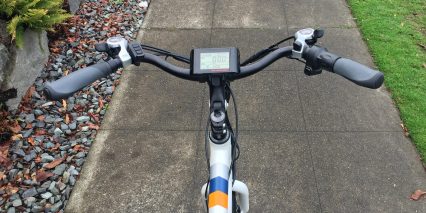



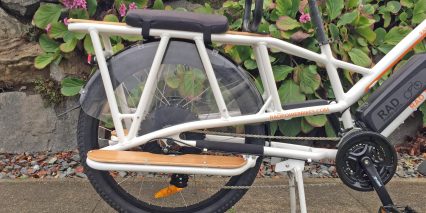

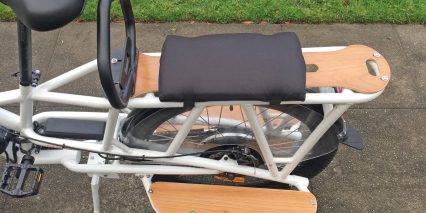

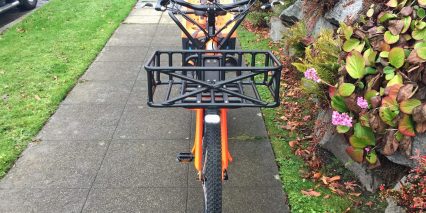

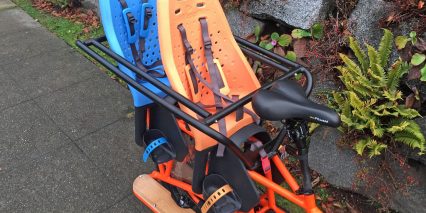


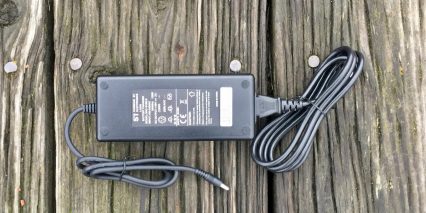






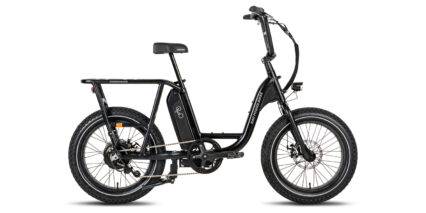














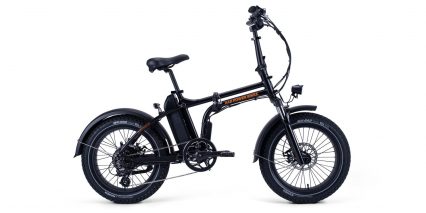







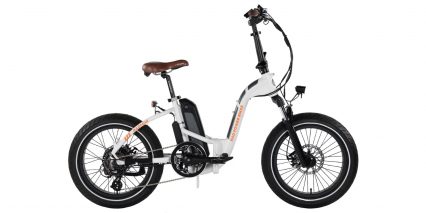
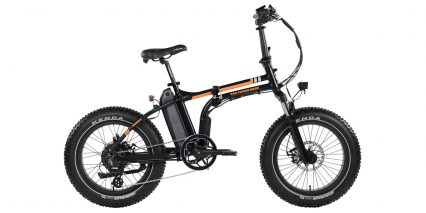



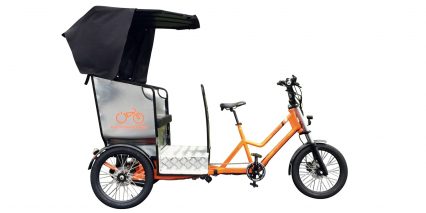









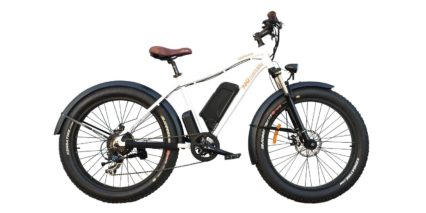
Aron
7 years agoSo I bought one of these a year ago and have been having a great time both carrying two kiddos (3&4) around and just getting around town with it. I’m not a real biker (i.e. I’m lazy) so the combination of electric assist and flexible cargo space has been a total game-changer when the crucial decision is made on whether to grab the car keys or the bike keys.
When comparing feature sets, I really don’t understand how this thing is priced at $1.6K when the closest comparisons (Yuba, R&M, etc.) seem to be $4K and up? Are they just selling these at cost? It’s such a huge difference…
Looks like it’s gotten even better with the 2018 updates. The headlight on mine is pretty underwhelming, and it looks like they upgraded it from 200 lumens to 300. They added battery capacity, although I think I might’ve preferred a smaller/lighter one. The only other thing I’m not that fond of is the 21 speeds, which is way more complication than I personally need. Maybe other people need that fine of control though. The disc brakes, mentioned here as a negative, work great for me. I don’t have super-powerful hands (that I’m aware of) but it’s still reasonably easy to skid the tires.
One thing I wish I understood more is whether it’s OK on this bike to carry an adult on the back. I did a few times before we put the cage on the back for the kids, and I had a motor problem. Their support was great and they sent out replacement parts promptly, but I could never get a clear answer on whether we somehow overloaded it and caused it to go out.
ReplyCourt Rye
7 years agoHI Aron! I agree that 21 speeds is a lot… and am seeing more and more ebike companies move to one-by drivetrains with just one shifter and 7 to 11 gears in a cassette. I think in terms of price, Rad is able to stay affordable because they don’t sell through dealers, are using simpler parts like hub motors vs. mid-drives, and they offer the hydraulic disc brakes etc. Some of those little hardware updates, like the derailleur, brake brand, even the tires, can add a lot to the bottom line. As for your question about carrying a second adult, my impression is that it depends on their weight, the terrain you’re on (flat or hills) and how hard you are willing to pedal along. You may strain some of the components if you load the bike up over the 350 lb maximum total weight (275 lb Rider, 120 lb Rear Rack, 40 lbs Per Running Board). Many parts will require tuning or replacement down the line even when you don’t stress them… so really pushing the bike could result in bent or broken spokes, a hot motor controller, maybe even some bearing issues etc. though I haven’t heard a lot about this sort of thing. You could always post about it in the Rad Power Bikes Forums and get feedback from other owners :)
ReplyAron
7 years agoThanks Court. Meant to say great job on what you’ve built here, it’s pretty inspiring. Hopefully you get that a lot and are sick of hearing it :). Besides being really well done, it’s clearly a passion project and that shines through.
elizabeth
5 years agoHey I was wondering if the bar end cap is easy to take off for a bar end mirror, and if you can put it back on after it’s removed? I want to put a bar end mirror on to save room on the handlebars, but I don’t want to make it look gross if i change my mind down the road. Thanks!
ReplyKenneth M Hildebrandt
3 years agoYou can, I did with mine. It offered a more stable view of my rear when the bike hit bumps, the top of the handlebar offers little sight past your shoulder so its hard to see incoming in the blind spots, plus the bumping road can make it blurry to see.
ReplyCourt
3 years agoThanks for the feedback Kenneth!